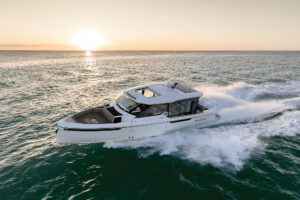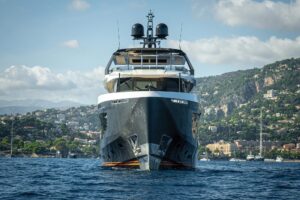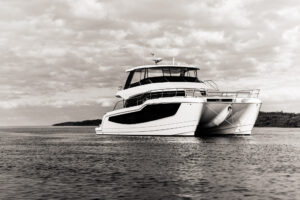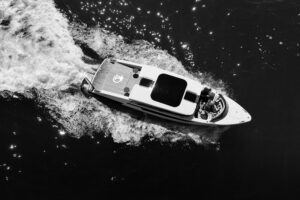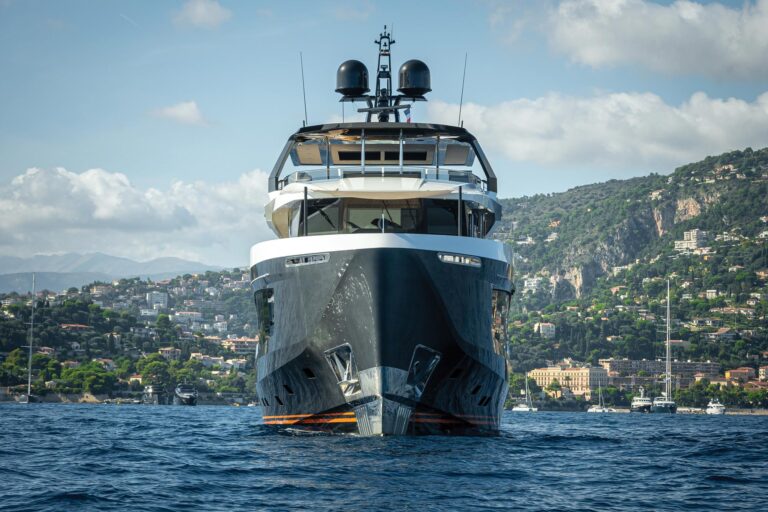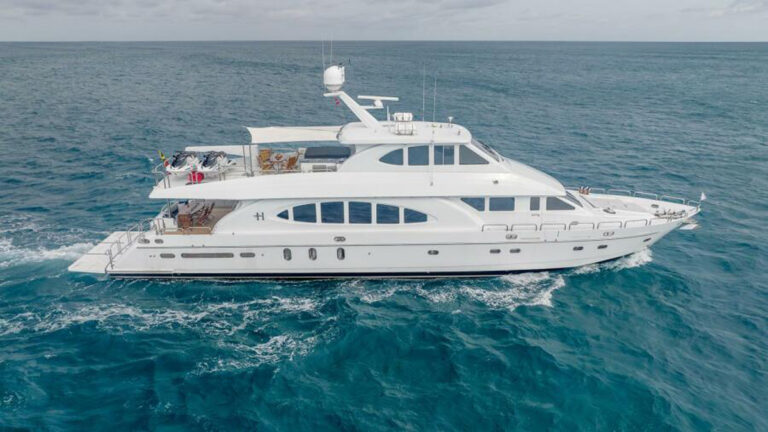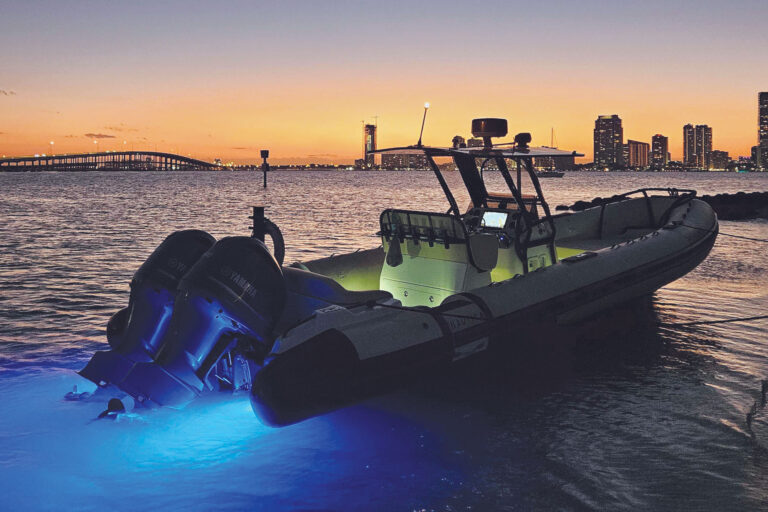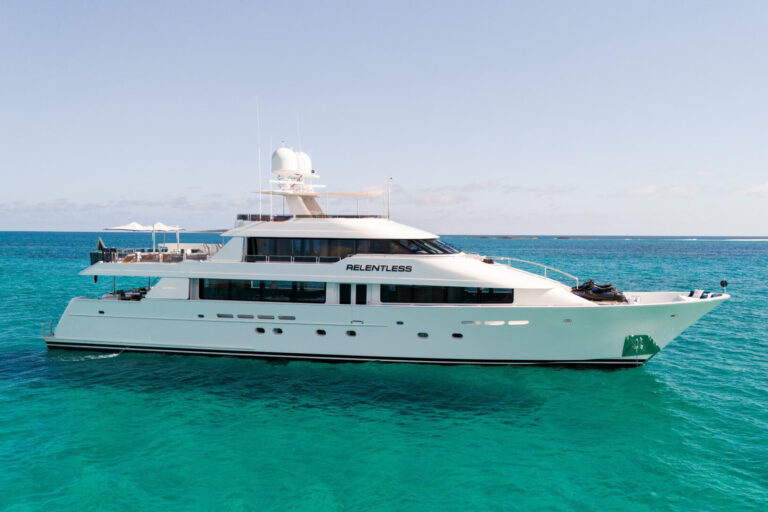If I were in charge of props for a film set in a waterfront town during the late 1930s, I’d order a Coastal Flyer 39 from Santa Cruz Yachts. More than any other fresh design in recent years, this yacht captures the spirit of a gentleman’s commuter/weekender (Design, April 2000) and releases it squarely into this century. Unlike the other boats in a category I’ll call “personal yachts (Hinckley Picnic Boat, San Juan 38, Shelter Island Runabout), which trend toward a variation on the Bunker and Ellis Down East theme, the Coastal Flyer has a personality all her own.
Dave Gerr clipped cues from his storehouse of knowledge about boat designs of the early 20th century to guide his hand. Lance Brown, general manager of Santa Cruz Yachts, dipped into the parts bin of the same era to add touches of detail that establish the boat’s overall look and character. Stepping aboard the 39 at the float in Annapolis, Maryland, made me feel as though I’d stepped into a blue blazer over white trousers, red braces and a sky-blue shirt.
Gerr freely admits Brown’s nearly obsessive attention to details raised the 39 from a role of character boat to a yacht of exceptional character. One of my favorite details is the custom-cast, stainless-steel stem head. It completes the Coastal Flyer like a sparkling smile completes the face of a beautiful person.
For other details, Brown took inspiration from the custom and hot rod auto industry that has been so prominent in Southern California since the late 1940s. The notion of using machine-turned, stainless-steel instrument surrounds and dashboard panels comes from the SoCal custom car scene. Brown couldn’t find ones that fit his needs, so he had a metal shop make them. Same goes for the little knobs atop the toggle switches. These used to be stainless-steel ball bearings. The banjo steering wheel, with mahogany rim, also is automotive. Mounted to the shaft via a marine adapter, it perfectly suits the boat’s character.
Most boats in the personal yacht field are outside/inside boats, with most of their use occurring in the open areas abaft the main bulkhead. The Coastal Flyer is no different. Hull number one is a hardtop and open from the windscreen to the transom. Hull number two, scheduled to be an express with standard trim, is expected to have a single seat opposite the helm and a bench at the after end of the express bridge.
More significant differences among the personal yachts appear belowdecks. The amount of volume below and the level of amenities installed depend on the boat’s overall size and what segment of the market the builder wants to capture. The Coastal Flyer 39 is fairly large for a 39, so her relatively voluminous interior has permitted an interesting, but usable, arrangement plan. Mahogany ceilings, bookshelves and a burgundy settee opposite the double berth help to make her cozy and comfortable.
A single person could live aboard the 39, if he specified a soft closure for the bridge-deck saloon down South or a hard enclosure for harsher climates. There is stowage under the berth and settee, plus a five-drawer dresser and a hanging locker opposite the galley. One-pot chefs could make good use of the two-burner cooktop, the oven/broiler and the Sub-Zero refrigerator/freezer, and the sink is large enough to use without dumping water all over the cabin sole. A loving couple could cruise the 39 for a week, or more, without feeling claustrophobic.
Don’t let the styling make you think of the Coastal Flyer 39 as a floating anachronism. On the contrary, she rides on a Gerr Vee bottom. She gets her power from a slick Yanmar diesel and her drive from an UltraJet water jet. Santa Cruz Yachts, inventor of the “fast is fun movement to speedy ultralight sailboats of the 1970s, builds the 39 to high standards from “appropriate-tech materials. She is, without question, a modern boat.
Each Gerr Vee has a fine, steep entry and a forefoot deeper than you would expect. The bottom transitions to a more shallow (though still quite steep) V-shape amidships, then flattens to about 24 degrees on the run to the transom. The sections soften from sharp V-shape to inverted bell, and the chines become shallow arcs. Although the Chesapeake Bay was nearly flat when I drove the Coastal Flyer, my previous experience aboard a similar Gerr bottom supported his claim of an easy ride.
Jet drive and a bow thruster give the Coastal Flyer moves that belong in a water ballet. Side-slides, pirouettes, nearly instantaneous stops and reverses, and a sashay or two are part of the repertoire. The single engine/water jet combination is an unobtrusive, economical way to propel a boat at moderate speeds. Extreme shoal draft and exceptional maneuverability at walking speeds are the main advantages of a water jet. I love these qualities, but I can’t get used to the way jets accelerate. They remind me of the old Buick DynaFlow two-speed automatic transmission from the 1950s-lots of revs and little movement. Modern jets are nowhere near that bad, but I still prefer the instant response of a propeller.
When I drove the Coastal Flyer, Gerr and UltraJet hadn’t worked out the optimal impeller, so we were down about 300 rpm from max, giving us a top speed of 20 knots at 3000 rpm. A new impeller and subsequent sea trials by Santa Cruz showed a top speed of 24.8 knots at 3300 rpm.
Brown said hull number one is a bit porky, displacing about 20,000 pounds loaded, and a 450 hp Yanmar (instead of the 420) will power subsequent models. Hull number one is really a prototype built more heavily than normal so engineering can work backward to lighten the structure without compromising strength. Hull number two ought to displace about 17,000 pounds and top out at 27 knots. Santa Cruz expects hull number three to dip into the low 15,000s, inching the top speed close to the 30-knot target.
Santa Cruz set the base price at $595,000. A loaded boat, such as hull number one, reaches into the high $600,000s. This is a small price to pay for distinctive styling, great handling and top-notch construction.
Contact: Santa Cruz Yachts, (831) 475-9627; fax (831) 475-0867; www.santacruzyachts.com.

